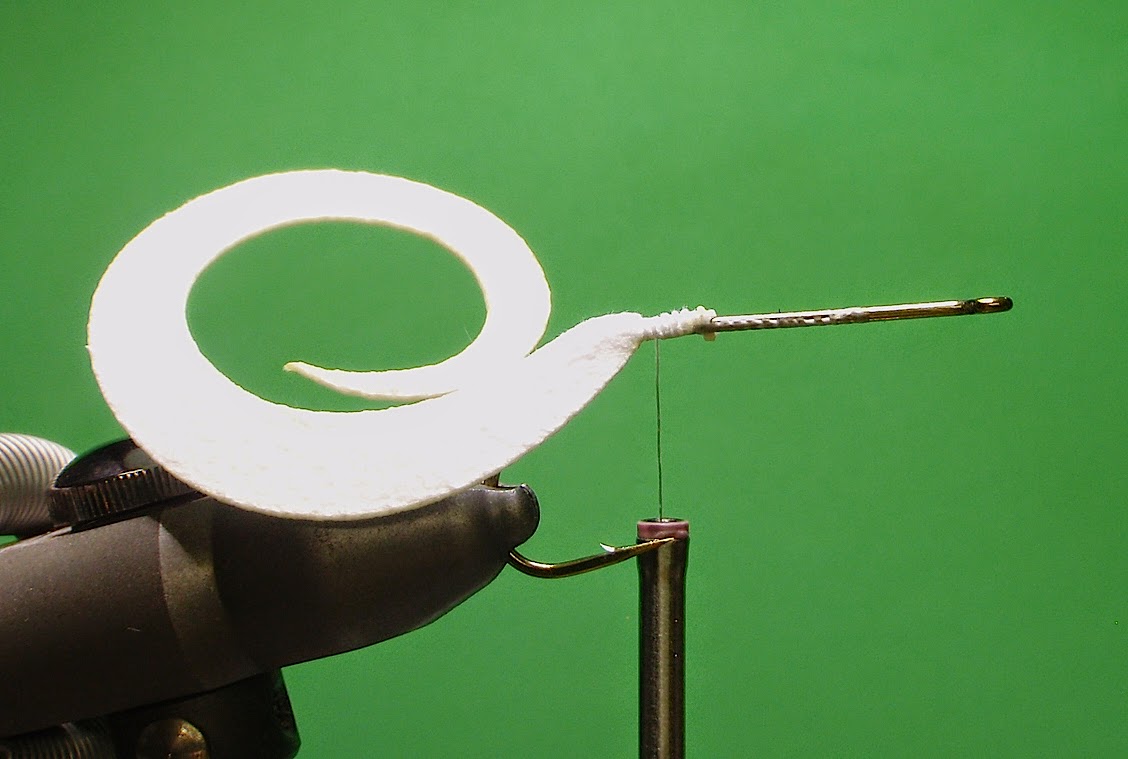"Zuddy's Shaker" is a pattern I spent all last summer working to perfect... at this point I couldn't be more pleased with it's performance so I hope you will give it a try as well. As summer progressed the bass seemed more and more to be eating it tail first, then hesitating (with the fly in their mouth) to make sure it was real before turning... this is the reason I added the loop of Fireline, so a stinger hook can be added if this is occurring often. You can fish this fly on a floating line with great success, I did find however that an intermediate bass line is slightly better. I generally work this fly pretty fast but don't be afraid to experiment with retrieval speed to find what works best. Use the rod tip and strip/pause retrieve to give the fly an irrisistable action. White is my favorite color for this fly but feel free to experiment with other color combos as well.
The photo above shows the materials used for this pattern.

Step 1. Place a Daiichi 2461 Size 1 hook in your vice. Cut an 8 inch long piece of 14lb test Berkley Fireline and thread the tag ends through the top of the hook eye as shown. Start wrapping white thread over the Fireline on top of the hook. My choice for thread on this fly is Uni-Thread 3/0 because it will stretch... this will be handy for a future step. This loop will be used to attach a stinger hook if the fish are short striking.
Step 2. Fold the tag ends of the Fireline back against the underside of the hook and continue wrapping all the way to the bend of the hook, making sure the Fireline stays on top of the hook shank.
Step 3. As seen in the previous photo, advance your thread to the center of the hook (between the hook point and eye), then attach aluminum Sea Eyes securely to the top of the hook. This is where a stretchy thread comes in handy. As you can see in this photo I have pre-applied the Pearl Eyes with 5 minute epoxy (Zap-a-Gap is sufficient as well)
Step 4. Jam a 4mm Glass Rattle against the back of the Sea Eyes and secure with thread wraps, no glue will be needed as the Sea Eyes help keep the Rattle from turning.
Step 5. Add a sparse clump of UV White Buck Tail to the top of the Rattle.
Step 6. Add 3 strands of Pearl Flashabou above the Buck Tail... folded over the thread so as to create 6 strands total.
Step 7. Tie in a 5 to 6 inch long piece of UV Pearl Polar Chenille on top of the Rattle and advance thread forward to just in front of the Eyes.
Step 8. Wind the Polar Chenille forward over the Rattle, under the Eyes and make a few turns in front of the Eyes as well.
Step 9. Add a sparse clump of UV Buck Tail on top of the hook as shown, securing tight enough that it won't move when you trim it.
Step 10. Trim the tag ends of the Buck Tail and add a few more thread wraps to secure it in place.
Step 11. Turn the fly upside down and repeat Step 10 on the bottom side of the hook as shown above.
Step 12. Finish the fly with a nice thread wrapped head and you are good to go!
Thanks for your support! - Matt "Z" Zudweg


































.jpg)



